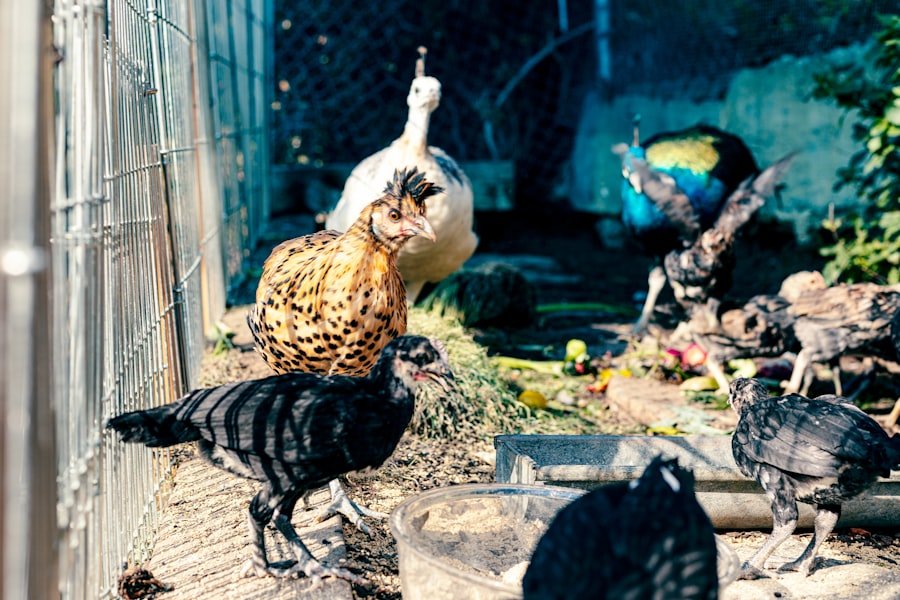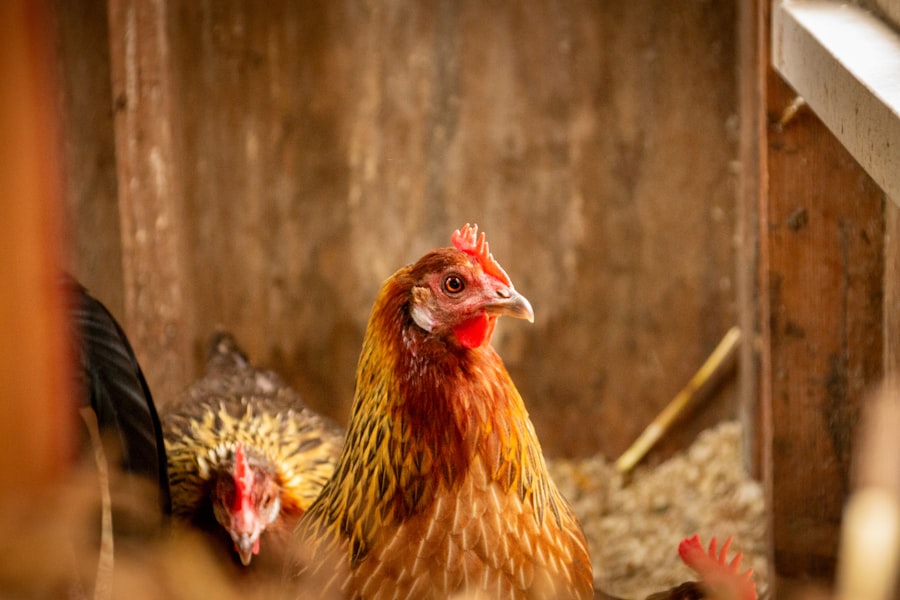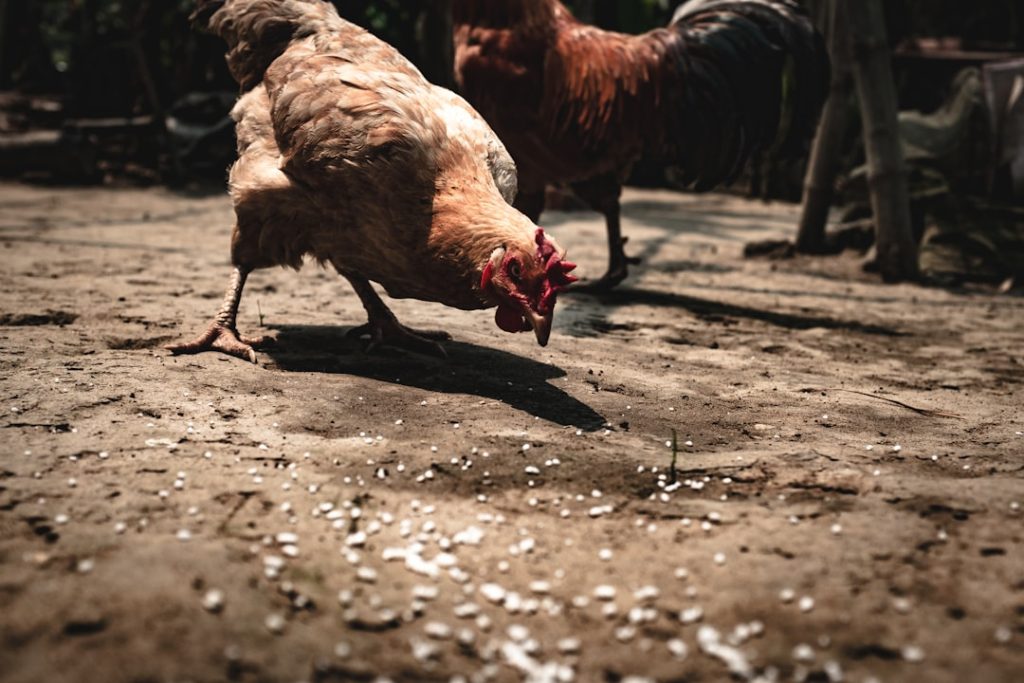Mites and lice are common parasites that can infest chickens, causing various health problems. Chicken owners must be able to identify these pests to take appropriate action. Mites are microscopic arachnids that feed on the blood of chickens, causing skin irritation.
They are often found around the vent area and under the wings. Lice are small insects that also feed on blood, causing itching and discomfort. They are typically found around the neck and vent area of chickens.
Both mites and lice can reproduce rapidly, necessitating prompt action upon detection. These parasites not only cause discomfort but can also lead to decreased egg production and overall flock health. Early identification is crucial to prevent severe infestations that may be challenging to control.
Regular health checks and close observation of chickens are essential for detecting mites and lice before they become a significant problem.
Table of Contents
- 1 Regular coop maintenance: Keeping the chicken coop clean and dry
- 2 Natural remedies: Using herbs and essential oils to repel mites and lice
- 3 Dust baths: Encouraging chickens to use dust baths to keep pests away
- 4 Diatomaceous earth: Using this natural substance to control mites and lice
- 5 Regular health checks: Inspecting chickens for signs of mites and lice
- 6 Quarantine and treatment: How to handle an infestation and keep it from spreading
- 7 FAQs
- 7.1 What are mites and lice and how do they affect chickens?
- 7.2 How can I prevent mites and lice from infesting my chickens?
- 7.3 What are some natural remedies for keeping mites and lice off chickens?
- 7.4 How often should I inspect my chickens for mites and lice?
- 7.5 What are some signs that my chickens may have mites or lice?
- 7.6 Can mites and lice on chickens affect humans?
Key Takeaways
- Mites and lice can be identified on chickens by checking for tiny, moving specks on their skin and feathers.
- Regularly clean and dry the chicken coop to prevent mites and lice from infesting the area.
- Herbs and essential oils such as lavender and neem can be used to naturally repel mites and lice from chickens.
- Encourage chickens to use dust baths by providing a designated area with fine dust or sand to help keep pests away.
- Diatomaceous earth, a natural substance, can be used to control mites and lice by sprinkling it in the coop and on the chickens.
- Regularly inspect chickens for signs of mites and lice such as feather loss, irritation, and restlessness.
- In case of an infestation, quarantine affected chickens and treat them with natural or commercial remedies to prevent the spread of mites and lice.
Regular coop maintenance: Keeping the chicken coop clean and dry
Regular Cleaning and Maintenance
Regular cleaning of the coop is essential in preventing and controlling mites and lice in chickens. This includes removing old bedding, droppings, and dust, which can help reduce the presence of pests. It’s crucial to pay special attention to areas where mites and lice are commonly found, such as perches, nesting boxes, and cracks in the coop walls.
Keeping the Coop Dry
Keeping the coop dry is vital, as mites and lice thrive in damp environments. Good ventilation and proper drainage can help keep the coop dry and inhospitable to pests. This can be achieved by ensuring that the coop is well-ventilated and that any water spills or leaks are quickly cleaned up.
Good Coop Management Practices
In addition to regular cleaning, practicing good coop management is essential in preventing infestations. This includes using clean bedding, providing dust baths for the chickens, and regularly inspecting the birds for signs of pests. By maintaining a clean and dry coop environment, chicken owners can greatly reduce the risk of mite and lice infestations in their flock.
Natural remedies: Using herbs and essential oils to repel mites and lice

Many chicken owners prefer to use natural remedies to repel mites and lice, rather than relying on chemical treatments. Herbs such as lavender, mint, and thyme are known for their insect-repelling properties and can be used in the coop to deter pests. These herbs can be hung in bunches around the coop or added to nesting boxes to help keep mites and lice at bay.
Additionally, essential oils such as tea tree oil, eucalyptus oil, and neem oil have been found to be effective in repelling pests. A few drops of these oils can be added to the chickens’ dust bath or diluted and sprayed in the coop to help control mites and lice. Using natural remedies not only helps to repel pests but also provides a safe and non-toxic alternative to chemical treatments.
However, it’s important to use these remedies with caution, as some herbs and essential oils can be harmful to chickens if used in excessive amounts. Consulting with a veterinarian or experienced chicken keeper can help in determining the appropriate use of natural remedies for pest control.
Dust baths: Encouraging chickens to use dust baths to keep pests away
Dust baths are an important part of a chicken’s natural behavior and play a crucial role in keeping pests such as mites and lice at bay. Chickens instinctively use dust baths to clean themselves and rid their feathers of parasites. Providing a designated area for dust bathing, such as a shallow box filled with sand, diatomaceous earth, or wood ash, can encourage chickens to engage in this behavior regularly.
Dust baths not only help in controlling pests but also contribute to the overall health and well-being of the birds. In addition to providing a dust bath area, it’s important to ensure that the material used is free from contaminants and regularly replenished. Chickens will often use dust baths after roosting at night or during the day when they are free-ranging.
By encouraging this natural behavior, chicken owners can help their flock in controlling mites and lice without relying on chemical treatments.
Diatomaceous earth: Using this natural substance to control mites and lice
Diatomaceous earth is a natural substance that is widely used for pest control in chickens. It is made from fossilized remains of diatoms, which are tiny aquatic organisms, and is known for its abrasive properties that can effectively kill mites and lice. When applied to the chickens’ feathers or dust bath area, diatomaceous earth can help in controlling pests by causing damage to their exoskeletons, leading to dehydration and death.
It’s important to use food-grade diatomaceous earth when treating chickens for mites and lice, as other forms may contain harmful additives that can be toxic to the birds. When applying diatomaceous earth directly to the chickens, it’s important to take precautions to prevent inhalation of the fine particles by wearing a mask and applying it in a well-ventilated area. Regular use of diatomaceous earth as part of a pest control regimen can help in keeping mites and lice at bay without resorting to chemical treatments.
Regular health checks: Inspecting chickens for signs of mites and lice

Visual Inspection
When inspecting the birds, it’s essential to look for visible signs of pests such as redness or irritation around the vent area, under the wings, or on the skin. Additionally, observing the chickens’ behavior for excessive scratching or feather loss can indicate a potential infestation.
Hands-on Inspection
Handling the birds gently can help identify pests that may be hiding in their feathers or on their skin. Using a magnifying glass can aid in spotting tiny mites or lice that may not be visible to the naked eye.
Prevention is Key
Regular health checks should be part of every chicken owner’s routine care for their flock in order to catch pest infestations early on. By incorporating regular health checks into their routine, chicken owners can prevent severe infestations and ensure the health and well-being of their flock.
Quarantine and treatment: How to handle an infestation and keep it from spreading
In the event of a mite or lice infestation in a chicken flock, it’s important to take immediate action to prevent the spread of pests to other birds. Quarantining affected chickens in a separate area away from the rest of the flock can help in preventing further infestation while treatment is administered. This also allows for closer monitoring of affected birds during treatment.
There are several treatment options available for controlling mites and lice in chickens, including chemical sprays, powders, and natural remedies. It’s important to carefully follow the instructions provided with any treatment product and consult with a veterinarian if necessary. Additionally, thorough cleaning and disinfection of the coop and equipment is crucial in preventing re-infestation after treatment.
Regular monitoring of the flock after treatment is important to ensure that the infestation has been effectively controlled. It’s also important to continue practicing good coop maintenance and pest prevention strategies to minimize the risk of future infestations. By being proactive in handling an infestation and taking steps to prevent its spread, chicken owners can effectively manage mites and lice in their flock.
If you’re looking for more tips on keeping your chickens healthy and happy, check out this article on large chicken coop ideas. A well-designed coop can help prevent infestations of mites and lice by providing a clean and comfortable living environment for your birds.
FAQs
What are mites and lice and how do they affect chickens?
Mites and lice are external parasites that can infest chickens, causing irritation, discomfort, and potential health issues. They can also reduce egg production and overall chicken well-being.
How can I prevent mites and lice from infesting my chickens?
To prevent mites and lice, regularly clean and inspect the chicken coop, use dust baths, and consider using natural or chemical treatments to keep the parasites at bay.
What are some natural remedies for keeping mites and lice off chickens?
Natural remedies for mites and lice on chickens include diatomaceous earth, essential oils, and herbal sprays. These can help repel and kill parasites without using harsh chemicals.
How often should I inspect my chickens for mites and lice?
It’s recommended to inspect your chickens for mites and lice at least once a week, especially during warmer months when parasites are more active.
What are some signs that my chickens may have mites or lice?
Signs of mites and lice infestation in chickens include feather loss, irritated skin, decreased egg production, and visible parasites on the chicken’s body.
Can mites and lice on chickens affect humans?
While mites and lice that infest chickens are specific to poultry and generally do not affect humans, it’s still important to practice good hygiene and take precautions when handling infested chickens.
Meet Walter, the feathered-friend fanatic of Florida! Nestled in the sunshine state, Walter struts through life with his feathered companions, clucking his way to happiness. With a coop that’s fancier than a five-star hotel, he’s the Don Juan of the chicken world. When he’s not teaching his hens to do the cha-cha, you’ll find him in a heated debate with his prized rooster, Sir Clucks-a-Lot. Walter’s poultry passion is no yolk; he’s the sunny-side-up guy you never knew you needed in your flock of friends!







